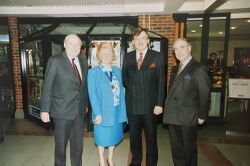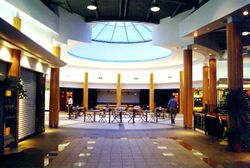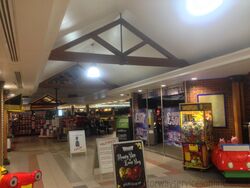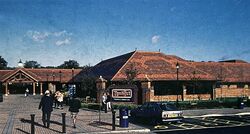History of Clacket Lane services
The two buildings at Clacket Lane were designed to form a gateway to Kent and Surrey, who's border it sits on. The westbound side, once the first service area for traffic coming up the newly-completed M20, was also a gateway to England, with a traditional English design trying to mimic a courtyard. Some of that styling was applied to the eastbound side, such as the brick wall around the building.
This is the history of Clacket Lane.
Planning and Opening

See also: M25 Service Area Planning
The 40-acre site of Clacket Lane was chosen from around five possible locations on this part of the M25, a road that was originally envisaged as a leisurely wind through leafy countryside. Clacket Lane was held as a back-up site from 1971, with Chevening being the preferred site but confirmed as being unusable in 1976.
Between J5 and J6 (known as the 'Titsey Woods' option, or more generally, 'Westerham'), three individual sites were being repeatedly assessed. For ease of identification, those three were named Titsey Woods, Clacket Lane and Brasted - Clacket Lane being literally named after the adjoining street. That option was chosen and the unusual name stuck - specifically with that spelling, even though the lane itself tended to be spelled differently.
The decision to change the name from Titsey Woods to Clacket Lane was to identify the three options and not, as some websites have suggested, because there were fears 'Titsey services' wouldn't be taken seriously. In each amenity building there is a large cabinet titled 'The History of Titsey Woods', which has several Roman artefacts which were discovered whilst the service area was constructed.
Roadchef later said that they were unhappy with the name Clacket Lane, and that they would rather call it 'Sevenoaks'. It soon became an important landmark on the M25.
The Department's change from pursuing Chevening to the reserve site at Clacket Lane caused the Daily Mail to claim Clacket Lane services had been planned in secrecy.
The design of the road bridge at Clacket Lane was modified to make space for the future service area in March 1977. This was a feature of the M25 when it opened here in 1979.
The eastbound forecourt was the subject of a protest on 28 April 2022, during which it was vandalised. Further vandalism caused both forecourts to close on 24 August 2022.
Policy Review
In 1983, the Department of Transport reviewed its policy for new service areas on the M25.
This considered a long list of possible sites, including an unusual one that would have been attached to the eastern side of the M23 interchange and the possibility of bringing back the Chevening plan. A special mention should be given to Tandridge District Council's insane 'Harps Wood' proposal, where the service area would have been built in the middle of M23 J7, where it would be dangerous to reach and far away from the M25, but it would at least be safely outside the district of Tandridge. Four more realistic options were shortlisted: Clacket Lane, Titsey Wood, Park Wood and Godstone. The Godstone site was positioned at M25 J6, and later promoted by Esso.
The Clacket Lane plan again came out top - it was in a good position for traffic and well-screened by trees. Clacket Lane continued to be strongly opposed locally. The Campaign Against Titsey Service Area (CATSA) argued no service areas should be built in this area at all.
The Department of Transport began a second Compulsory Purchase Order in order to acquire trees to the north of the site, to ensure they could be used as landscaping, but residents argued this was an inappropriate use of power. To tackle the mounting complaints, the Department of Transport made an unusual commitment to avoid expanding Clacket Lane. This commitment, which was probably informal at best, would have been long forgotten when the building opened, and especially once it was sold.
Plans moved forward in 1986, but the decision was subsequently taken to the High Court by objectors. The High Court raised issues with the Department of Transport's leasing procedures, which meant that many other planned service areas had to be put on hold.
Construction

Tender documents were finally issued in February 1991. As it was one of the last service areas to go through this Department of Transport process, it was also one of the most detailed. The successful developer was required to lease space within the building to a tourist information centre, and to provide a rear access. The westbound side needed to have 97 toilets, and parking spaces for 400 cars, 74 lorries, 15 coaches and 3 caravans. The eastbound side could be marginally smaller, with 92 toilets and parking for 350 cars, 72 lorries, 15 coaches and 3 caravans. A 2000 square metre picnic area was required on each side.
The bid was eventually shortlisted down to six candidates: Welcome Break, Granada, Roadchef, Blue Boar, BP and Esso.
Roadchef won the contract later that year and spent £35million developing the service area (around £74million in 2025). It was built by Moss and Wallis.
The building looked much like the supermarket design at the time, with one newspaper calling it "a toned-down, Tesco-style bungalow"; supermarkets would call it 'Essex Barn'. Its controversial past meant it needed to have low buildings, and went for "local rural architectural detailing" with timbered trusses inside. The building architect was Dancey and Meredith and Travers Morgan worked on the exterior. There was a burger bar called Route 25, the café Cafe Continental, and a truck driver's café at the end of each building called Juggernauts. In total there were 400 seats on each side of the road, and 100 toilets.
The tourist information office had a large promotion for the Sally Line ferry service. The westbound building included a sculptured water fountain, designed by William Pye and named 'Flyover'. A press release called the sculpture "the first major sculpture for a British motorway service area". It was dismantled in around 2008.
Both forecourts were selected by Roadchef to be operated by Elf and were completed ahead of schedule, opening on 24 May 1993. The forecourts were Elf's first motorway site in the UK. They had a total of 160 fuel pumps, forming one of the largest forecourts in Europe. The final figures were a total of 770 car parking spaces, 150 HGV parking spaces and 30 coach spaces, making what was believed to be the biggest motorway service area in the country.
Roadchef's 10th motorway site officially opened three months early on 21 July 1993, with Robert Key MP, Minister for Roads and Traffic in attendance along with Cecilia Gerrard, Chairman of Surrey County Council and racing driver Damon Hill.
Brand Changes

As with many Roadchef service areas, the eastbound used to have a long corridor design. Westbound was slightly different, with a shorter corridor leading to a more prominent atrium.
On both sides, the burger bar soon became Wimpy, while the restaurant became onRoute, and the shop became reStore.
The filling stations rebranded to Total in the late 1990s following the merger of Elf and Fina. They were both sold to Shell in early 2012 following their nationwide shutdown before Shell passed them to BP in September 2013.
The service area was Roadchef's first site to gain electric vehicle charging points. These opened as Engenie, before changing to Ecotricity. It is now a GRIDSERVE charging hub.
The fast food units became McDonald's in 2012, with a large seating area that crossed the main corridor. This meant the restaurant areas had a much smaller servery. The Bread Kitchen was also trialled here.
A Carvery Express kiosk was trialled on the eastbound side here alongside Watford Gap northbound in 2016 but both were removed in 2017.
A SPAR was trialled here in the forecourt in 2003, before being introduced again in 2016 to the amenity building.
Pret a Manger opened here on 16 March 2018. The Pret a Manger store then closed in early 2020 to make way for a new Leon restaurant.
The hotel here included a Regus Express meeting room for a time. This was removed in 2019.
The Fresh Food Cafés were closed in early 2023, citing low levels of sit-down trade.
Survey Results
In 2025, Which? Magazine ranked Clacket Lane 46th out of the 90 service areas they visited.
The 2022 Transport Focus survey calculated a 95% satisfaction score for both sides of the service area, placing it in the top quarter. The following year, both sides scored 92%: a respectable result that still saw it placed in the bottom quarter of the league table.
In Spring 2021, Which Magazine placed Clacket Lane in the middle of the table, with a 51% customer satisfaction score.
In Spring 2017, Transport Focus calculated a 92% satisfaction score for the westbound service area and 79% for the eastbound service area. In 2018 this had risen to 94% and 83%, and it rose again in 2019 to 96% and 85%.
In 2015, the service area were rated 4 stars by VisitEngland.
In May 2012 and August 2011, VisitEngland rated the service area as 3 stars.
Lord Adonis (Secretary of State for Transport) said he was "very impressed" by the service area when he made a surprise visit in September 2009, saying it was clean and provided a good meal.
The service area were inspected by The AA on 24 and 25 March 2007. These are their results:
| Category: | Rating: |
| Road safety and parking: | Good |
| Outdoor facilities: | Acceptable |
| Access and indoor facilities: | Acceptable |
| Catering: | Acceptable |
| Shop: | Very Good |
| Family Friendliness: | Acceptable |
| Service: | Good |
| Hygiene: | Acceptable |
| Pricing: | Very Poor |
| Final Score: | Acceptable |
The service area said to be well supervised with a good range of items in the shop and restaurant. The food wasn't tasty though, it had no picnic benches or indoor play area, it was very expensive and it was described as dirty, with the fold-away baby changing tables being described as "hazardous to health".
The service area was also inspected by The AA on 3 and 4 April 2004. These are their results:
| Category: | Rating: |
| Road safety and parking: | Good |
| Outdoor facilities: | Acceptable |
| Access and indoor facilities: | Good |
| Catering: | Acceptable |
| Shop: | Very Good |
| Service: | Acceptable |
| Communications: | Very Poor |
| Hygiene: | Very Poor |
| Pricing: | Very Poor |
| Final Score: | Poor |
In this test, the service area was said to be well prepared and tasty. Again, the variety of stock in the shop was brought up, and again the site was described as "extremely dirty". The shop was expensive and the staff were unfriendly, too.
A 1995 review in The Independent gave the service area three stars.

